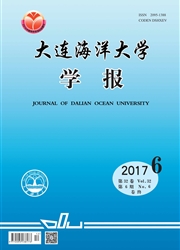

 中文摘要:
中文摘要:
为了解东海近海蟹笼主要渔获蟹类的渔业生物学特性,于2012年秋季至2013年冬季,采用延绳作业方式开展了4次海上蟹笼捕捞试验,对主要渔获种类三疣梭子蟹 Portunus trituberculatus和红星梭子蟹Portunus sanguinolentus的渔业生物学进行了测定。结果表明:2012年秋季和2013年冬季的三疣梭子蟹渔获群体较2012年冬季和2013年春季群体更大,两种蟹类的雄性较雌性略大;三疣梭子蟹和红星梭子蟹的甲宽(CW)与体质量(W)关系分别为W=5.077×10-4CW2.533和W=1.388×10-4CW2.797;秋冬季雌性三疣梭子蟹的性腺发育阶主要分布于Ⅰ~Ⅲ期,雄性发育阶主要分布于Ⅱ~Ⅴ期,且发育阶与甲宽呈显著的正相关关系(P〈0.01);雌性红星梭子蟹性腺发育阶主要分布于Ⅱ~Ⅲ期,而雄性发育阶主要分布于Ⅲ~Ⅴ期;三疣梭子蟹的条件指数为(5.65±0.94) g/mm3,且与甲宽呈显著负相关关系(P〈0.01),而红星梭子蟹的条件指数为(5.78±0.75) g/mm3,且与。与早期研究结果相比,蟹笼渔获群体结构异常,生长方程幂指数减小,发育阶下降,这些都反映出当前蟹类资源波动加剧,群体可能呈小型化、个体生长加速、发育减缓的趋势,在今后蟹笼渔业管理中需要进一步探索最小可捕标准。
 英文摘要:
英文摘要:
In order to investigate the fishery biological characteristics of main crab species caught in the offshore crab pot fisheries, 4 trials in sea experiments with longlining pots were carried out from autumn in 2012 to winter in 2013 in the East China Sea. The fishery biological characteristics of swimming crab Portunus trituberculatus and redspotted swimming crab Portunus sanguinolentus, which dominated the catch, were measured and then analyzed. The results showed that there was larger population of crabs caught in autumn of 2012 and winter of 2013 than that caught in spring and autumn of 2013, larger in male crab than in female crab. The relationships between carapace width ( CW ) and body weight ( W ) of swimming crab and red spotted crab were expressed as W=5 . 077 × 10-4 CW2.533 and W=1. 388×10-4CW2.797, respectively. The female swimming crab caught in autumn and winter had go-nad with stages Ⅰ-Ⅲ, and male red spotted crab had gonad with stagesⅡ-Ⅴphase, positive relationship of de-velopmental stage with carapace width. The female red spotted crab caught in autumn and winter had gonad with stages Ⅱ-Ⅲ, and male ones had gonad with stages Ⅲ-Ⅴ. The swimming crab had condition factor of ( 5 . 65 ± 0. 94)g/mm3, with significantly negative correlated to carapace width. The red spotted crab had condition factor of (5. 78±0. 75)g/mm3. Compared to the previous study, the abnormal size frequencies, decrease in exponents of re-lationship between CW and W and condition factor reflected the possible trends of intensification of fluctuations in crab stock and population miniaturization, growth acceleration and development slowing down of crab individuals. It is suggested that the minimal catchable size of swimming crab be further studied in fisheries management.
 同期刊论文项目
同期刊论文项目
 同项目期刊论文
同项目期刊论文
 期刊信息
期刊信息
